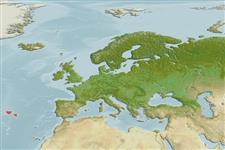Klassifizierung / Names
Namen | Synonyme | Catalog of Fishes(Gattung, Arten) | ITIS | CoL | WoRMS | Cloffa
>
Eupercaria/misc (Various families in series Eupercaria) >
Labridae (Wrasses)
Etymology: Symphodus: Greek, syn, symphysis = grown together + Greek, odous = teeth (Ref. 45335); caeruleus: Named for th edistinctive blue coloration of males.
Environment: milieu / climate zone / depth range / distribution range
Ökologie
seewasser demersal; standorttreu; tiefenbereich 1 - 30 m (Ref. 35939), usually 5 - 15 m (Ref. 35939). Tropical; 39°N - 36°N, 32°W - 24°W
Northeast Atlantic: Madeira, Canary Islands and the Azores Islands.
Size / Gewicht / Alter
Maturity: Lm ? range ? - ? cm
Max length : 21.5 cm SL Männchen/unbestimmt; (Ref. 35939); 17.5 cm SL (female)
Kurzbeschreibung
Bestimmungsschlüssel | Morphologie | Morphometrie
Rückenflossenstacheln (insgesamt) : 17 - 18; Rückenflossenweichstrahlen (insgesamt) : 8 - 9; Afterflossenstacheln: 5 - 6; Afterflossenweichstrahlen: 7 - 9. Modal count of rays on dorsal fin 26 and anal fin 14; scales on lateral line 33-34; dark blue coloration of the males during spawning season (Ref. 35939).
Oviparous, distinct pairing during breeding (Ref. 205). Males build dish shaped nests and guard the eggs (Ref. 205).
Life cycle and mating behavior
Geschlechtsreife | Fortpflanzung | Ablaichen | Eier | Fecundity | Larven
Oviparous, distinct pairing during breeding (Ref. 205). Males build dish shaped nests and guard the eggs (Ref. 205).
Azevedo, M., 1999. Centrolabrus caeruleus sp.nov., a long unrecognized species of marine fish (Teleostei, Labridae) from the Azores. Bocagiana 196:1-11. (Ref. 35939)
IUCN Rote Liste Status (Ref. 130435: Version 2024-1)
Bedrohung für Menschen
Harmless
Nutzung durch Menschen
Tools
Zusatzinformationen
Download XML
Internet Quellen
Estimates based on models
Preferred temperature (Ref.
123201): 18.7 - 19.1, mean 18.8 °C (based on 9 cells).
Phylogenetic diversity index (Ref.
82804): PD
50 = 0.5005 [Uniqueness, from 0.5 = low to 2.0 = high].
Bayesian length-weight: a=0.01000 (0.00471 - 0.02125), b=3.07 (2.90 - 3.24), in cm total length, based on LWR estimates for this Genus-body shape (Ref.
93245).
Trophic level (Ref.
69278): 3.5 ±0.5 se; based on size and trophs of closest relatives
Widerstandsfähigkeit (Ref.
120179): mittel, Verdopplung der Population dauert 1,4 - 4,4 Jahre. (Preliminary K or Fecundity.).
Fishing Vulnerability (Ref.
59153): Low vulnerability (16 of 100).
